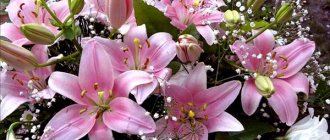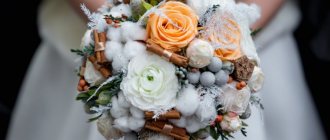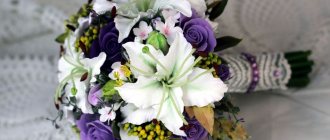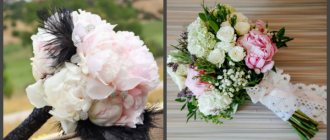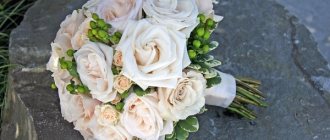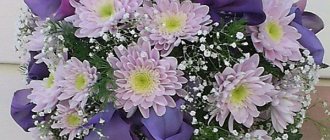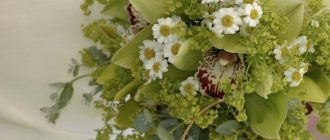Symbolism
At a symbolic level, peonies mean prosperity, wealth and protection , therefore, in the bride’s bouquet, these flowers will program the new family for a happy and strong union, as if protected from problems by a divine shield.
Other interpretations of the symbolism of peonies:
- in Greece , the homeland of peonies, they were considered a talisman against the evil eye and any evil, which would also be useful at a wedding;
- in China the flower was associated with imperial grandeur;
- in Japan it was a sign of potential fertility - lush peony paths were planted at the windows of girls of marriageable age.
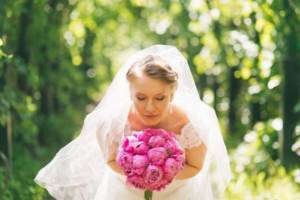
Interesting! Even the degree of openness of the buds is important for interpretation.
Those barely blooming symbolize a very young girl, and a fully open flower symbolizes the captivating femininity of an older young lady. The color of the buds also matters:
- A bouquet with red peonies emphasizes sensuality, passion and at the same time boundless devotion;
- The darker the color, the more aristocratic it is, so burgundy peonies in a bouquet already mean the divine blessing of the nascent union;
- White buds are traditionally associated with innocence, purity of soul, and the beginning of a new life;
- Pink, cream and other pastel shades will emphasize the tenderness of the bride, her romance and dreaminess;
- Purple is suitable for a creative, creative person.
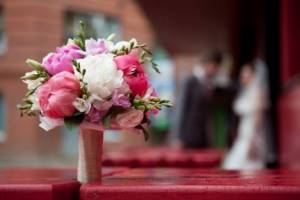
Flower symbolism
Today, peonies are found in almost any garden; they attract many with their appearance, which is similar to majestic roses, as well as their ease of care. These flowers have long been common both in Europe and in the countries of the East, and therefore there are many different legends about their origin.
In Ancient Greece, there was a legend according to which the flower was named after the physician Peon, who was able to heal even the gods. With his skill, the doctor surpassed his teacher, who, out of envy, decided to poison the student. Peon found out about this and asked for help from the gods, who turned him into a fragrant flower.
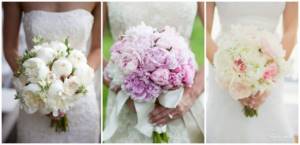
In other countries there are also many beautiful tales associated with the appearance of peonies. These flowers are especially revered in China, where they have always been a symbol of nobility and grace; entire gardens were planted with them. In Japan, noble people planted peonies in front of their houses to attract suitors for their daughters. It was believed that these buds helped the girls themselves to be witty and bewitching when communicating with their future husband.
In the language of flowers, a bouquet of peonies illustrates a man’s promise to give his woman the whole world. In many cultures, this flower is considered a symbol of a happy marriage and fertility, so it can be safely used in a wedding bouquet. Before composing a bouquet for the bride, it is necessary to take into account the meaning of each flower, since some plants are simply not suitable for a wedding celebration.
Depending on the shade of the buds, the symbolic meaning may vary. For example, a composition of pink peonies symbolizes tenderness and tender love between lovers; from whites - modesty, purity and purity of intentions; from red or burgundy - passion and devotion.
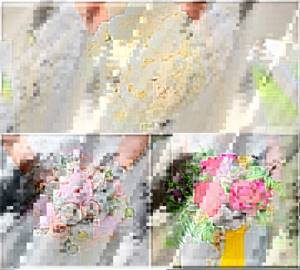
What kind of brides are they suitable for?
Peony compositions are perfect for both very young, dreamy girls and self-confident young ladies who know what they want from life. A rich palette of shades will allow you to choose your combination for any color type.
Peonies are a great option for brides who:
- they want to save money, because during the flowering period, that is, from May to July, peonies are very cheap;
- choose a wedding in the style of rustic, eco, vintage, Provence;
- they dream of a lush, luxurious, but not too strict bouquet;
- appreciate the romance and femininity of these enchanting flowers.
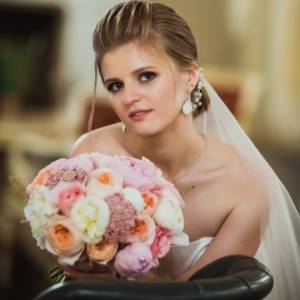
Do-it-yourself bouquet of peonies: instructions
If you need a bouquet for a wedding, you don’t have to contact a professional florist. You can make a stylish composition with your own hands. Here are short instructions on how to make a beautiful bouquet of peonies on your own stems:
- Use pruning shears to remove leaves from the stem. This is necessary so that the stems of the flowers fit snugly against each other. The greenery around the buds can also be cut off or left at your discretion.
- If there are any defects on the outer petals, they must be removed.
- The assembly begins with the central flower and then proceeds in a spiral. We take one flower, apply a second one crosswise to it, the next one also in a spiral, etc. That is, the central one is kept in one place, and the rest are laid around it. It is important to hold the stems tightly so that the spiral does not fall apart.
- The second row of the spiral is placed slightly lower than the first, so that the bouquet takes on the shape of a hemisphere. Make sure the composition is symmetrical.
- Carefully, without breaking the plants, gather the stems into one “tail”. Slightly stretching the tape, wrap the stems from the base (a little away from the buds) downwards to form a “handle” of the bouquet.
- Trim the stems at a distance of approximately 6 cm from the “handle”.
- To decorate, wrap the “handle” from bottom to top with a satin ribbon. Carefully tuck the end of the ribbon and secure it with a safety pin with a head that matches the color of the ribbon.
All the details can be seen in this video:
Ideas for wedding bouquets with photos
You can create an effective accessory with your own hands; fortunately, peonies have quite powerful long stems that are easy to work with.
It is possible to either create a round or cascading bouquet with a stem, or use additional devices, for example, a porta bouquet holder with a special sponge filled with cool water. This will not only allow you to play with the shape of your bouquet. Moisture reserves will have a beneficial effect on the condition of the petals, preventing them from drooping or flying around even in less than ideal conditions.
Idea! The cascade shape of the bouquet also looks original, but in this case it is better to decorate the composition with a variety of greenery to add freshness.
Peonies make gorgeous exotic options - a pomander, an absolutely round sphere attached to your hand with a ribbon, or rosamelia, a giant flower made up of several dozen buds. Disguised joints make you believe that this is really a huge exotic plant, and the keen interest of all guests in the accessory during the holiday is guaranteed.
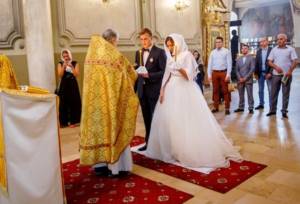
Monobouquet
Peonies are absolutely self-sufficient flowers, so mono bouquets of one color or another look great. A red, pink, purple cloud in the hands of the bride looks charming, especially if the leg of the accessory is wrapped in fabric or paper of the desired shade. A pastel mono bouquet is perfect for a vintage or rustic celebration.
If you choose snow-white buds, the overall image will turn out incredibly airy, gentle and sublime. In this case, it is better to leave the stem free so as not to hide the juicy greens. You just need to lightly grab it with a satin ribbon of the same shade as the buds. It is advisable to insert a wire frame into the stem to ensure that the bouquet does not fall apart.
To prevent the white bouquet from blending in with the snow-white wedding dress in the photographs, add more greenery to it. This will set boundaries, but will not destroy the unearthly harmony of the overall picture.
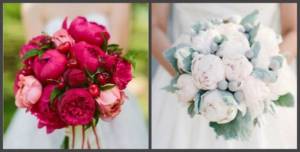
Ideal compositions
Wildflowers, for example, lilies of the valley, go well with snow-white peonies, but such a juxtaposition is only possible when the wedding is planned during the flowering period. You can dilute the whiteness with bright colors of cornflowers, violets, tulips, blue irises, and daffodils. All field plants calmly coexist with each other and with peonies, without trying to displace their neighbors from the vase with secreted toxins.
Roses, lilies, and orchids are suitable for peonies of more saturated shades. Such a bouquet automatically becomes chic, but it is less durable, since the listed flowers have a negative attitude towards the neighborhood - each type of flower will have to be placed in its own vase.
The combination of peonies with freesias, hydrangeas, ranunculus, anemones, and eucalyptus looks interesting. For weddings with a more democratic, rustic design, use gerberas, daisies, a variety of greenery and lilac blossoms.
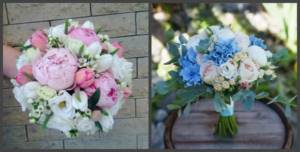
Freesia
Freesia is a flower of trust, admiration and respect. Its delicate aroma, neat lace-like shape of the petals and abundance of shades make it an excellent frame for large, fluffy peonies.
Since freesia is also presented in cold colors - shades of blue and blue, limitless possibilities for floristic experiments open up before you . A combination of blue and yellow, blue and white, purple and cream looks good.
Idea! An entirely scarlet, pink or white composition of peonies interspersed with contrasting freesia accents is interesting.
Bouquets of different flowers, but of the same shade, are also beautiful. If desired, use a gradient that is fashionable today with a transition from larger and more saturated peonies in the center to light and miniature freesias along the edges.
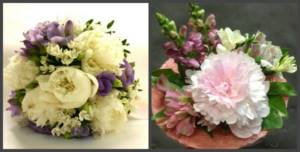
Peony roses
Elegant, aristocratic roses or delicate peonies, full of life and spring? The breeders decided that there was no need to choose, and they bred a number of varieties of peony roses that took the best qualities of both parents.
The most common variety is David Austin, which has cup-shaped buds, a magical aroma and a huge palette of colors. Typically, David Austin roses are collected in delicate pastel compositions and used at vintage weddings, because the appearance of the flower directly refers to retro style.
The advantages of peony roses, in addition to their external beauty, include greater resistance to influences, natural and physical, although the bouquet still remains fragile and not very suitable for a frosty winter wedding.
Both round and cascading bouquets of peony roses look good. You should be careful with more original forms - they are acceptable, but think about how exactly you will play with the mixture of modernity and antiquity.
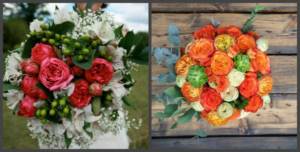
Delicate ranunculus
Ranunculus resemble small peonies, and therefore seem to be created to combine with their older brothers.
At a symbolic level, this Iranian flower means tenderness and happiness , it is distinguished by good resistance to external factors and a wide variety of colors.
The classic version is a round bouquet , where there are several peony buds in the center, and small ranunculi at the edges, differing by two or three tones. This combination will show your ideal taste and ability to play with details.
Another idea is rich red peonies, asymmetrically scattered as if carelessly across a canvas of white or cream ranunculus. In this case, the bouquet will emphasize the contrasting fusion of boundless passion and innocent tenderness.
The main problem with using these flowers at the same time is that they do not have the same flowering time. If peonies bloom from May to July, then ranunculi bloom from February to April. So be prepared that you will have to order this or that flower from abroad.

Hydrangea
Hydrangea is a fluffy ball of many small flowers. This form goes well with more substantial peony buds, adding airiness and enthusiasm to the overall composition.
The symbolic meaning of hydrangea is sincerity, trust and hope , which makes the flower a welcome guest in a wedding bouquet.
Hydrangea next to peonies will be more of a frame than the main character, but when creating a field, village bouquet, you can not choose the central flower, but add lilacs, daffodils, and irises in equal proportions.
Advice! Using more than three pure colors in equal proportions makes the bouquet overly bright and flashy. If you want multicolor, don't forget to add more greenery. Then bright colors will fit perfectly as accents and will not conflict with each other.
An extremely delicate bouquet will be made from white, pinkish or cream flowers tone on tone. Unexpected splashes of scarlet, purple, burgundy on snow-white are also possible, and hydrangea may well become this accent.
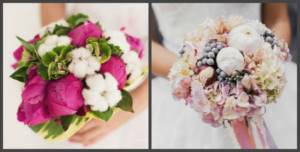
Eucalyptus
Eucalyptus is considered the plant of life. This greenery comes in a variety of varieties - dusty gray cineria hearts, large fresh robusta leaves, neater small shoots of hanna and many other varieties.
Eucalyptus has a characteristic scent, adds volume to the bouquet and outlines its boundaries, making the composition more complete and neat. The use of eucalyptus in combination with lush, but visually slightly blurred peony buds is especially relevant.
Eucalyptus looks great both in the classic round shape of a bouquet and in a cascade. You can change not only the size of the leaves, but also their shade , because it varies from bluish to gray, which means you can fit the bouquet into any range of the overall wedding design.
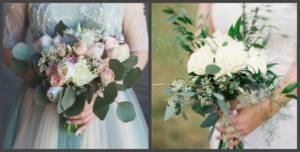
Anemones
The meaning of anemones is fragility, emotionality and innocence. These flowers are really very delicate, and therefore a bouquet with them should be held extremely carefully and placed in a vase as soon as possible. These inconveniences are more than made up for by their exciting appearance.
The combination of peonies and anemones is the most romantic, touching, almost reverent. It is suitable for dreamy, modest brides, thin and short. Paired with a simple flowy dress, the accessory will create a truly ethereal look.
Anemones come in many colors – there are both pastel and bright colors. Scarlet or purple anemones will fit perfectly into both pink and rich red bouquets of peonies.
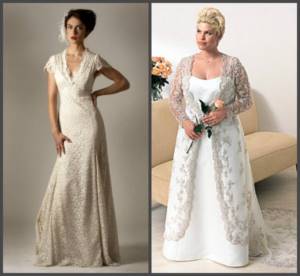
Orchids
The orchid is a very aristocratic flower, meaning fidelity, elegance, and prosperity.
Interesting two-tone colors allow you to create unusual combinations; for example, you can choose peonies of the same shade as the core of its exotic neighbor.
The palette of orchids is very extensive; there are buds with edging or flirty spots. Bouquets in one color look very stylish, for example, pure white or diluted only with a contrasting orchid core. The cascade form is ideal for this combination. She will turn the bouquet into a real work of art, and the bride into a fairy-tale princess from a distant southern country.
An orchid, just like a rose or a lily, does not tolerate any proximity in a vase. The flower releases toxic substances that poison other plants. Therefore, if you want the bouquet to last longer, you will have to separate the flowers.
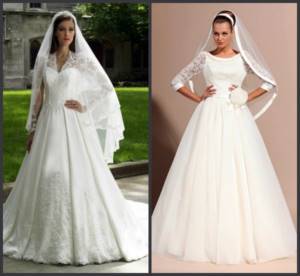
Options for combinations of peonies of different colors
Peonies for a wedding[—what is best to combine with? box type=”fact”]Peonies are one of the few flowers that can rightfully be called bright and original. Therefore, to create a complete image, you may only need one type of flower.
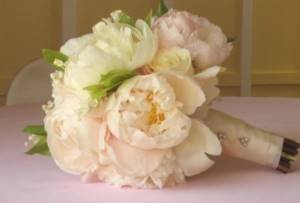
If you want to be more vibrant and original, you can use the following successful combinations:
- Roses are considered to be the most beautiful flower. That is why it is most often combined with other buds. It is important at this moment to choose the right color scheme. If you are using a combination of two varieties, then it is better to choose several colors. At the same time, they should all be in approximately the same tone: some will be more pink, some will be more muted. For example, peonies can be a pastel shade of pink, but roses in this case are a rich crimson.
- Monobouquet is the most popular option, because it can be played out in different ways. This is achieved not only thanks to a different palette, but also thanks to an interesting stylistic design. For example, a wedding bouquet can be tied with a thick and dense colored ribbon or be in a weightless box that is neatly tied with a bow.
- Orchids are rightfully considered a mysterious flower. Why not combine mystery and tenderness in one bouquet? The flowers in it can complement each other. And you will say more about your original and creative personality.
Color spectrum
An absolutely white bouquet remains an ageless classic. A small amount of greenery or bright accents, of course, will make it more lively and fresh, but even in its pure form, white monochrome looks magical, adding trepidation and innocence to the bride. This clean dye goes well with a traditional white or off-white outfit.
Idea! For a dress in shades of ivory or champagne, a more delicate cream bouquet is better suited. It is not forbidden to complement it with blue, light pink, yellow flowers.
The next most popular is a pink bouquet. Peonies are presented in a whole palette of this shade: from powdery to purple. The first ones are suitable for a delicate vintage look if you try to dilute them with small white flowers. The second is for the more romantic and feminine. Bright fuchsia looks extremely stylish, especially in combination with smaller flowers of yellow or purple tones.
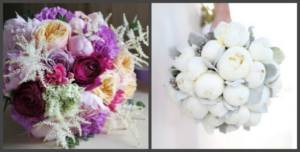
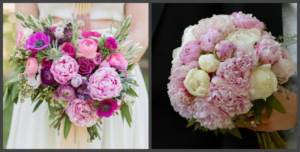
A red bouquet will suit bright, confident brides. This hot color looks especially good on brunettes. Be sure to add an accessory to your look that matches the bouquet - it could be lipstick, shoes, earrings.
Such attention to detail will definitely not go unnoticed. A burgundy bouquet looks incredibly luxurious, regardless of what flowers are included in it. This is a royal color that requires an appropriate frame, so if you choose it, then focus the rest of your look on elegance rather than charm.
An even more saturated color bouquet will be made from purple flowers - such a composition is perfectly diluted with yellow, blue, and pink shades. A light and fresh duet of purple and cream. Rare blue peonies will cause everyone's delight, because they are wonderful both solo and framed by blue or white flowers.
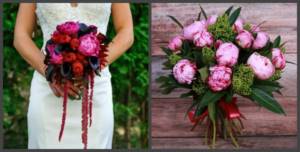
What flowers can complement a wedding bouquet of peonies?
Most often there are bridal bouquets consisting only of peonies.
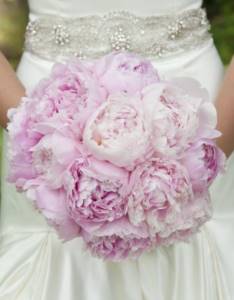
Mono bouquet only of peons
However, with the help of experienced florists, you can add a “zest” to the composition by adding other flowers and greenery.
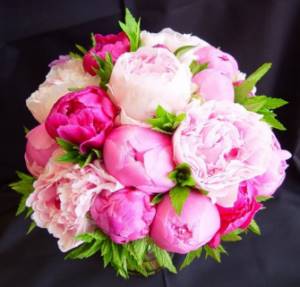
Mono bouquet of peons combined with greenery
Peonies combine interestingly with poppies, ranunculus, callas and roses. Hibiscus and freesia will help to emphasize the tenderness of the inflorescences.
Here is a great example of a bouquet of white peonies and roses:
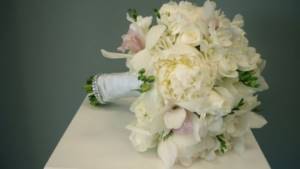
Combination with roses
Shape: small, cascade, pomander, rosemelia
When choosing a form, focus on the theme of the wedding, the general image of the bride and her external characteristics:
- cascades with an abundance of greenery are good for tall girls , classic round ones, pomander, rosamelia are good for short girls;
- thin brides should not choose too voluminous compositions , because they will distract attention from the hostess of the celebration, but overweight brides should not choose too thin and modest options;
- vintage style goes better with rounded lines of the bouquet , eco-wedding - with a cascade.
Peonies hold their shape well, but if you make a ball out of them, don’t forget about a sponge, because these capricious plants can endure drought for several hours at most, after which they will lose their charming appearance.
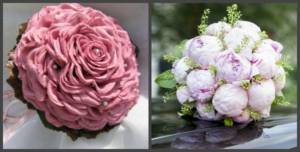

Variety of shapes
You can choose the freshest and most luxurious flowers, decorations and vegetation for your wedding bouquet. But this is not enough. You need to skillfully combine all this so that it matches the dress and hairstyle of the bride. In this matter, the shape of the future accessory plays an important role.
Globular
The classic form is universal; it is perfectly suited for peonies. Large fluffy flower heads easily form a hemisphere in a spiral, and smaller half-open buds fill the gaps.
This composition is suitable for a girl of any size due to its long stems and neat appearance. Special harmony in the image is achieved when the bride chooses a traditional fluffy wedding dress.
Cascade
Otherwise, this form is called falling. The top of the bouquet looks like a thinned hemisphere, and the lower part lengthens and falls. Usually the top is made up of blossoming peonies, and the bottom is decorated with young buds, leaves, and greenery. To dilute and create naturalness, spray roses, freesias, eustomas, as well as various greenery are added to the composition: fern, sedge, bindweed, decorative peas.
A cascading floral arrangement is ideal for tall, thin brides in tight-fitting dresses without a train or heavy jewelry. Looks great at a boho wedding.
Structural
Previously, florists arranged flowers in the shape of a heart, which today is considered a hackneyed theme. Now an abundance of other forms have appeared, the general name of which is structural bouquet. Peonies look great in such a composition, because they allow you to combine natural ones, as if they were just collected by the bride in the garden.
Structural compositions are good for celebrations in eco or Provence style. They will harmoniously complement a flowing style dress made of translucent tulle, silk or organza.
Extended
A mono-bouquet of white or soft pink inflorescences with long stems looks cute and elegant. Flowers that can be used to dilute the splendor of the bunch are callas, gerberas, roses, and irises.
This option is recommended for tall young ladies. It will highlight their figure favorably. It is better to choose a straight-cut dress for this accessory.
Tussy-mussy
This is a kind of mini version of the normal semicircular bouquet. Several peonies, complemented by greenery, can create such a composition. The bouquet looks charming in the hands of young petite brides. It is recommended to create it from light flowers, as they visually look larger.
The composition will suit a dress of any length. This is the best solution for a retro style wedding.
Decor
You can decorate a bouquet of peonies with a wide variety of accessories - fabric, lace, satin ribbons.
Idea! Rhinestones that imitate dew drops or small beads look touching. For example, a pastel bouquet is perfectly complemented by matching artificial pearls.
More specific elements are also acceptable - feathers, butterflies, stars, hearts. They can be either bright accents or support the overall scheme of the bouquet.
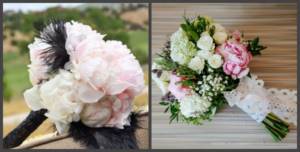

Features of peonies
When choosing a wedding bouquet of peonies, you should know the following...
Peony is not as popular among couples as roses. Therefore, by choosing this flower, you can stand out. And in order to capture the imagination of your guests, we suggest you use these flowers in the decoration of the restaurant for your celebration.
The color range of inflorescences ranges from rich red to white. For a wedding composition, both loose and tightly closed buds are used.
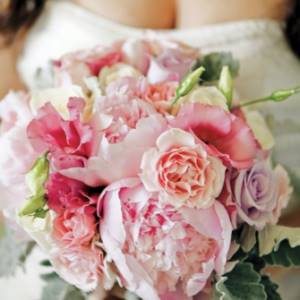
Various shades of pink
The main “disadvantage” of these flowers is that they quickly fade without water. Therefore, try to put the composition in a vase from time to time. Also, the day before the celebration, place the flowers in the refrigerator. If this is not possible, leave them in a cool but not humid place. Also remember that closed buds will bloom quickly if placed in warm water.
Flowering occurs in May-June. If the wedding is scheduled for this period, such a bouquet can cost you quite inexpensively in comparison with a similar arrangement of roses.
The aroma of flowers is subtle and unobtrusive. It will not tire the bride or cause a headache.
